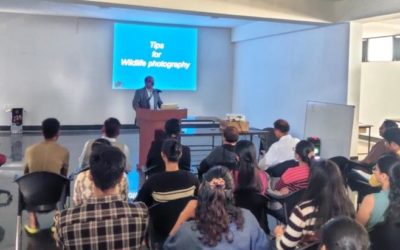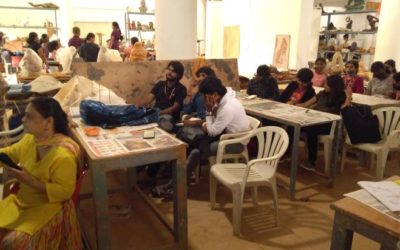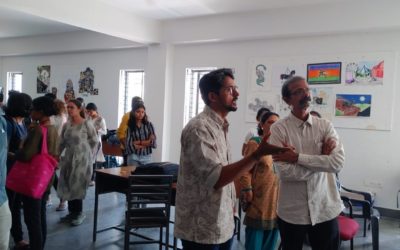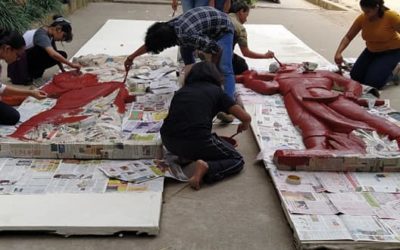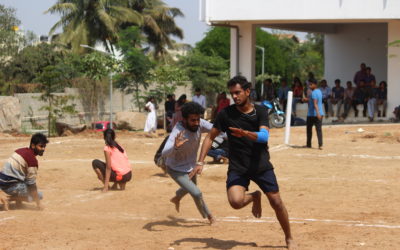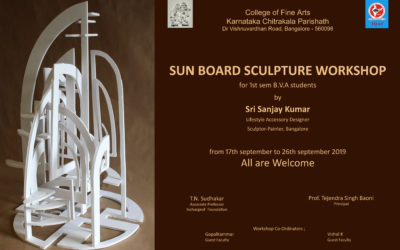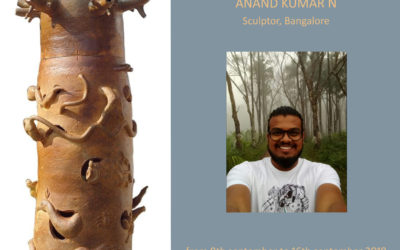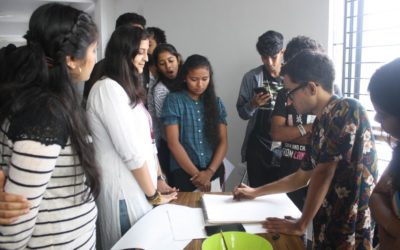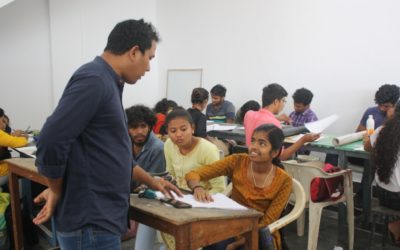BVA FOUNDATION
BVA foundation is a one year program, divided into two semesters. The course leads to the Specializations in Painting, Sculpture, Graphic Art, Applied Art, Animation and Art History in Undergraduate Degree.
The foundation course is an introduction to Visual Art and its approaches. It consists of Practical, Art History, Languages, Journal, Daily sketches from life, computer application, etc. Practicals are divided into five segments in the first semester – The objective of this on the whole is to build a sensitive coordination between eyes, hands, seeing, touching to drawing, painting and building relief. Alongside the students will also get well introduced to the field of fine arts like Painting, Printing, Sculpture and Applied Design. Art History will equip them with the history in a story form. It is to understand Art as a reflection of society at the core. It will have an introductory approach to develop skills of rendering, perceiving and expression as needed in visual arts.
Drawing | Drawing – I
Applied drawing, this class start with the basics of drawing and engages the students with a variety of drawing tools and techniques, through experimentation. Students will develop their drawing skills, as well as essential confidence to continue exploration. Objective to develop drawing and painting skills, exploring various drawing tools and imbibe a keen sense of observation along with hand eye co-ordination. Outline:(a) Exposure to diverse drawing techniques adopted by earlier artists. (b) Study of human figure in various media, study of human figure in groups. (c) Creative drawing with special emphasis on attributes of various drawing medium. (d) Introduction to various tools and material available like – pencil, charcoal, pastel, crayon, poster colours, water colour, oil colour, paper canvas and collage to the artist and their paper usage. (e) Rendering techniques.
Colour Composition
Scope:
It aims to build sensitivity towards colour, its co-relations and values to enhance expressions by use of colour. Introduce Great masters’ works of Indian, Western & Eastern. Introduction to Indian Miniature Journals
Visual record of images which are pleasing to the eye, with an explanation in few words stating the possible factors leading to it. Collection of visuals / photographs on particular subjects.
Nature Study
Scope:
To create awareness at various level like, spaces, perspective, colour, light & its changes /effects of colour & form, to develop keen observation & sensitively towards evolution of nature.
Content
Studies in details and simplification, study of plants its details for Ex. grass, flowers, fruits on the plants. Study of trees from line drawing to mass studies to develop an understanding of light & shade, character of nature. Few studies in landscapes. (Pen & ink, Poster colours, Pencil, water colour, charcoal, pastel)
Fundamentals of Visual Art (3D)
Scope:
Builds an understanding to understand and explore the feel, touch and scope and the Consequent experience of dimensional objects.
Content
Explore the nature of form, geometric shapes, mass, organic and inorganic forms by using various materials. Paper, board, clay, thermacoal, soap, wire, POP, etc. Introduction to the use of simple tools and techniques.
Art History – I
Scope & Guidelines:
Develops a skill of understanding, seeing, grasping and personally experiencing visuals of Indian artworks through the ages, in a chronological mode. It is an attempt to understand practical visual creations ‘through’ theoretic and historic understanding of the development of visuals. The story of art works tells the story of cultures in a visual media as against the well acknowledged written media. It is also an act to introduce the students to read more into what is visually created and its difference from naturally existing. It is an attempt to understand a concept called visual language.
- Developments in Indian Painting From Early to Modern Period
- To introduce, explain and discuss the art forms of Indian Art from Pre-Historic time to Contemporary period.
- Pre-historic Art and Mural tradition. Introduction to Bimbhetka and related sites Ajanta , Ellora , Madurai , Hampi ,Lepakshi , Shravanabelagola and Mysore.
- Survey of Indian Miniature Tradition Early Palm Leaf Manuscripts: Pala, Sena , Jain , Sultanate Manuscript , Rajasthani , Mughal , Pahadi and Mysore Traditional schools.
- Modern Indian Art Company school, Ravi Verma , Amritha Sher- Gil, Rabindranath Tagore , Bengal Revivalism , Art Before Independence : Bombay , Culcutta , Madras and Mysore.
- Introductions to Post – Independence Art
Fundamentals of Indian Sculpture and Architecture
- Beginning of Buddhist Sculpture and Architecture: Maurya , Kushana , Shatavahana and early Historic rock cut Architecture : Ajanta , Bhaja , Karle , Kanheria , Nasik.
- Developments in Hindu Temple Architecture and Sculpture: Gupta , Vakataka and Iconography.
Regional Schools :
Chalukya : Badami , Aihole , Pattadakal
Pallava : Mahabalipuram , Kanchi puram
Rashtrakuta : Ellora
Chola : Madhurai , Gangaikondacholapuram
Later Chalukya : – Lakundi Dambal , Itagi ,
Hoysala – Dodda Gaddavalli , Belur, Halebed , Somnathpur and Vijayanagar : Hampi .
Drawing | Drawing-II
The exploration of ideas introduced in beginning drawing I and moves towards a contemporary approach to ideas in drawing students will work with creative, colour, selective combinations of materials and a variety of drawing tools and surfaces.
a) Outline: Definition and understanding of terminologies in perspective like – Vanishing print (VP) Eye level (EL) Observer (O) Picture Plane (PP) Ground Line (GL)
b) Studies of objects of various shapes and sizes, confirming to the logics of perspectives.
c) Drawing of objects in linear (one point) angular (2 point) and mixed perspective.
d) Outdoor and indoor studies of various objects at different viewpoints angles and eye levels.
Pictorial Composition
Scope
It is the initial step in understanding the intricate of visual languages. It aims to provide the basic structural understanding of surface and the illusions that creates the basic elements in reading a picture plans.
Content
Simple exercises in collage from ready available images. Few exercises to understand visual elements-balance, contrast, colour balance, perspective, rhythm, movement etc. Exercises using daily sketches to build narratives. .
Printmaking
Scope
The practical subject expects the students to avail the primary understanding of repetitive patterns, which are commonly used in creating effective printing images. The course also intended to initiate them to experiment with negative and positive rendering of space, texture, and tones. Introduction to the expression and emotions of the simple basic forms in relation with given pictorial space.
Content
Study of Relief Printing (Wood/Lino) with composing simple figurative forms. Creating repetitive printing patterns, and impressions with the help of easily available materials like leaves, vegetables, wood, etc., Stencil cuts are also part of the study.
Objectives:
Printmaking helps the students to understand the usage of various surfaces and materials. The subject also promotes different types of building motifs and patterns in a repeated process of printmaking.
Guideline :
The subject of printmaking allows the students to differentiate and study the nature of manmade objects and organic objects. Students should study the interior and the exterior using lines, texture, tones in relation with the form and its expression. To explore this basic idea Indian and Western early wood cuts and Escher’s prints can be referred.
Calligraphy & Design
Scope
The Traditional Art of beautiful & graceful handwriting is known as Calligraphy. The art of Script or hand writing can be practiced any language such as English, Kannada, Hindi and many more languages. The Principles of spacing, layout and basic construction of letter and forms are very important characters in Calligraphy. The art of letter writing also helps in understanding then very aesthetic beauty of ancient scripts. It also gives immense freedom to create ones’ own letter style.
Contents
Study of basic strokes with pencil & flat nibs, Study of alphabets as a design element, Kannada, Hindi & English scripts with reference to their structure and design, designing layouts & paragraphs.
Objectives
Calligraphy by now as we know is an Art all can become Master. We will find calligraphy and fundamental alphabets simplify our whole approach to lettering. Every stroke is functional and every letter is harmonious. Once the idea is absorbed in a student ample opportunity begin to unfold from the personal interpretation of letterforms.
Guidelines
First Stage-Students will be learning different basic strokes with different directions of forms with flat pencil. Second Stage- Students will be learning alphabetical forms of Calligraphy writing. Using The Flat Pencil & Flat nibs Third Stage : Students are taught using of different flat nibs, colours and Developing of Design/ Layout.
Art History -II
Scope and Guidelines
Develops a skill of understanding, seeing, grasping and personally experiencing visuals of Western artworks through the ages, in a chronological mode. It is an attempt to understand practical visual creations ‘through’ theoretic and historic understanding of the development of visuals. The story of art works tell the story of cultures in a visual media as against the well acknowledged written media. It is also an act to introduce the students to read more into what is visually created and its difference from naturally existing. It is an attempt to understand a concept called visual language.
Survey of Western Art
To introduce, explain and discuss the art forms of Western Art from Pre-Historic time to Contemporary art, mainly from Europe.
- Prehistoric Art Introduction to important pre historic sites of Europe : Alta Mira , Lascaux etc
Introduction to early Civilization - Egypt and Mesopotamia
- Greek and Roman Art (study of Sculpture , painting and Architecture ) Development of Christian Art : introduction to early symbols and visual representations Byzantine, Romanesque, Gothic periods ( Painting , Sculpture and Architecture)
- Period of the Revivalism Renaissance, Mannerism , Baroque ( introduction to general features of painting , sculpture and Architecture )
- Rococo, Neo-Classical and Romanticism, French Realism, the ISMS and the post-Isms period.
Wildlife Photography Seminar, Date- 18th May, 2022
Title - Wildlife Photography Seminar Date- 18th May 2022 Department- Applied Art Department No. of students participated- 60 No. of faculties involved- 2 (Mrs Prakruthi. S and Dr G. O. Shivakumar) Description of the Seminar - This seminar was conducted by Dr...
Soft skills Workshop, Date- 16th May, 2022
Title – Soft skills Workshop Date- 16th May 2022 Department- BVA Foundation Department No. of students participated- 144 No. of faculties involved- 2 (Ms Chithra Unnikrishnan & Ms Tasneem Lohani) Description of the workshop - This seminar was conducted by Mrs...
Drawing and Painting Workshop, Date- 16th May, 2022
Title – Drawing and Painting Workshop Date- 16th May 2022 Department- BVA Foundation Department No. of students participated- 144 No. of faculties involved- 3 (Mr. Dushyanth H P, Mr. Sanjeev Rao Guthi and Mr. Anila Kumar Govindappa) Description of the workshop - This...
Making of Chitra Santhe
Sports Day
Sun-Board Sculpture Workshop 1st sem BVA – 2019
Terracotta Workshop 1st sem BVA – 2019
Cartoon and Caricature Workshop 1st sem BVA- 2019

